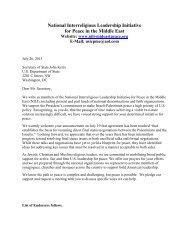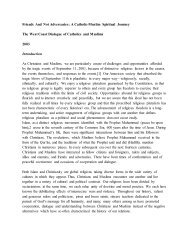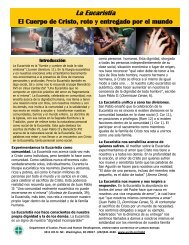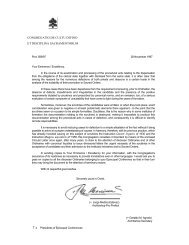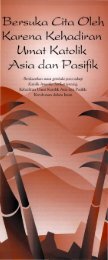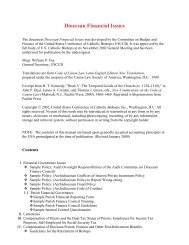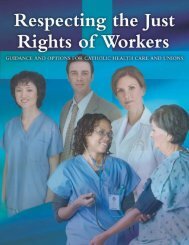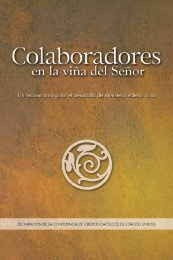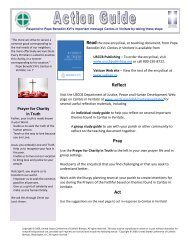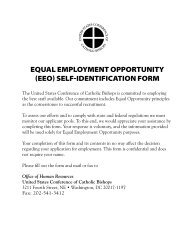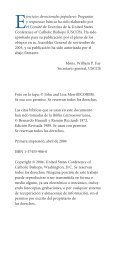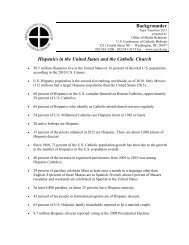Option B: History <strong>of</strong> <strong>the</strong> Catholic ChurchCourse Four presented a catechesis <strong>of</strong> <strong>the</strong> Church and <strong>the</strong> Body <strong>of</strong> Christ in history: its nature and meaning, images, marks,life and ministry, guide to moral life, and <strong>the</strong> role <strong>of</strong> prayer. This elective can supplement that catechesis on <strong>the</strong> Church.The purpose <strong>of</strong> this course is to supply <strong>the</strong> students with a general knowledge <strong>of</strong> <strong>the</strong> Church’s history from apostolic times to<strong>the</strong> present. They will be introduced to <strong>the</strong> fact that <strong>the</strong> Church was founded by Christ through <strong>the</strong> Apostles and is sustained by himthroughout history through <strong>the</strong> Holy Spirit. The students will come to know that <strong>the</strong> Church is <strong>the</strong> living Body <strong>of</strong> Christ today and,as such, has both divine and human elements. In this course, students will learn about <strong>the</strong> Church’s 2,000 years <strong>of</strong> history and abouthow <strong>the</strong> Church is led and governed by <strong>the</strong> successors <strong>of</strong> <strong>the</strong> Apostles.I. Christ Established His Church to ContinueHis Saving Presence and WorkA. The origin, foundation, and manifestation <strong>of</strong> <strong>the</strong>Church.1. Church planned by <strong>the</strong> Fa<strong>the</strong>r (LG, no. 2; CCC,no. 759).2. Church instituted by Christ who (CCC, nos. 748,763-766)a. Inaugurated <strong>the</strong> Church by preachingGood News.b. Endowed his community with a structure.c. Gave <strong>the</strong> Church totally <strong>of</strong> himself <strong>for</strong>our salvation.3. Church is revealed by Holy Spirit: fifty-daypreparation <strong>for</strong> Pentecost (CCC, nos. 767-768).a. The events <strong>of</strong> <strong>the</strong> first Pentecost.b. The Holy Spirit’s charisms in Church’s life(1 Cor 12–14).B. Holy Spirit inspires <strong>the</strong> Apostles’ mission—greatcommission (Mt 28:16-20; CCC, nos. 857-860).1. The missionary journeys <strong>of</strong> St. Paul.2. The role <strong>of</strong> Peter and <strong>the</strong> Apostles in <strong>the</strong>early Church.3. Apostolic Succession preserves <strong>the</strong> mission, <strong>of</strong>fice,and teaching <strong>of</strong> <strong>the</strong> Apostles as entrusted to <strong>the</strong>mby Christ (CCC, nos. 857-862).II. History <strong>of</strong> Church in Post-Apostolic Times1. An Age <strong>of</strong> Growth amid PersecutionA. Unique phenomenon in Roman Empire.1. Empire was tolerant in principle but changedregarding Christians who denied Roman gods andrefused to worship <strong>the</strong>m.2. “Blood <strong>of</strong> martyrs is <strong>the</strong> seed <strong>of</strong> <strong>the</strong> Church”(Tertullian [catacombs]).3. Teachings <strong>of</strong> St. Ignatius <strong>of</strong> Antioch, St. JustinMartyr, and St. Irenaeus sustained <strong>the</strong> faith <strong>of</strong> <strong>the</strong>persecuted Church.B. House liturgies—Eucharist is heart <strong>of</strong> early Christianworship.1. Transition from Last Supper to Breaking <strong>of</strong> Bread.2. <strong>Development</strong> <strong>of</strong> Liturgy <strong>of</strong> <strong>the</strong> Word and <strong>of</strong>Eucharistic Prayer.3. Descriptions in <strong>the</strong> Didache; St. Justin Martyr(Liturgy <strong>of</strong> <strong>the</strong> Hours, Vol. II, p. 694).2. The Age <strong>of</strong> <strong>the</strong> Fa<strong>the</strong>rs <strong>of</strong> <strong>the</strong> ChurchA. Constantine and Edict <strong>of</strong> Milan.1. Freedom <strong>of</strong> worship.2. From house liturgies to worship in public.a. Building <strong>of</strong> churches <strong>for</strong> Mass and celebrations<strong>of</strong> sacraments.b. Sense <strong>of</strong> transcendence <strong>of</strong> God in statelysettings.B. Fa<strong>the</strong>rs inculturated Scripture <strong>for</strong> Greek and Romanpeoples (CCC, nos. 76, 688).1. Influenced by Plato’s philosophy through Plotinus.2. With sermons and commentaries on Scriptureand sacraments.a. Preaching was a powerful means <strong>for</strong> catechesisand evangelization.b. Fa<strong>the</strong>rs and doctors <strong>of</strong> Church includeSt. Basil, St. Gregory Nazienzen, St. JohnChrysostom, St. Athanasius, St. Ephrem,St. Ambrose, St. Jerome, St. Augustine, St.Leo <strong>the</strong> Great, St. Gregory <strong>the</strong> Great. (N.B.Lives <strong>of</strong> saints should be mentioned throughoutthis course both to show <strong>the</strong> restoration <strong>of</strong> faithand hope in times <strong>of</strong> crisis as well as to illustrateways <strong>of</strong> encountering Christ through all periods <strong>of</strong>Church history.)C. The development <strong>of</strong> <strong>the</strong> Eastern Patriarchates.1. These were located in Jerusalem, Antioch,Constantinople, and Alexandria.2. The See <strong>of</strong> Peter in Rome in relation to <strong>the</strong>Patriarchates.<strong>Doctrinal</strong> <strong>Elements</strong> <strong>of</strong> a <strong>Curriculum</strong> <strong>Framework</strong> <strong>for</strong> <strong>the</strong><strong>Development</strong> <strong>of</strong> Catechetical Materials <strong>for</strong> Young People <strong>of</strong> High School Age35
D. Church councils and doctrinal development (CCC,nos. 9, 192, 250, 884, 887, 891).1. Church response to heresies (Arianism and Nes-torianism):Nicea, AD 325; First Constantinople,381; Ephesus, 431; Chalcedon, 451; and threelater councils.a. Creeds and catechesis <strong>for</strong> Christianinstruction.2. Dealt with doctrines <strong>of</strong> Incarnation and <strong>the</strong> Trinity.3. Some Eastern Churches began separating overdoctrinal disputes; <strong>the</strong> first separation occurred in431, <strong>the</strong> second in 451, and <strong>the</strong> third in 1054.3. The Roman Church <strong>of</strong> <strong>the</strong> WestA. Collapse <strong>of</strong> Roman Empire <strong>of</strong> <strong>the</strong> West around 476.1. Barbarian invasions; weakened government.2. Political influence <strong>of</strong> popes and bishops increased.a. Church was <strong>the</strong> remaining trusted authority.b. Helped maintain law and order amid <strong>the</strong>encroaching invaders.c. Assisted with protection <strong>of</strong> civilians andfeeding <strong>the</strong> poor.B. The monks as evangelizers.1. St. Benedict and <strong>the</strong> Benedictines.2. St. Columban and <strong>the</strong> Celtic monks.a. Brought Christ and Church to nor<strong>the</strong>rnEurope.b. Developed agriculture, wool production,vineyards.c. Stabilized <strong>the</strong> nomadic tribes and gave birthto towns.d. Monastic schools promoted education, culture,and classics.4. The Church <strong>of</strong> <strong>the</strong> Middle AgesA. Politics and religion.1. Charlemagne’s Frankish Empire.2. Clashes between Church and monarchies onselection <strong>of</strong> bishops.3. Gregory VII—Hildebrand and Gregorian re<strong>for</strong>m.B. New religious orders, new universities.1. Bernard and <strong>the</strong> Cistercians.2. Rise <strong>of</strong> <strong>the</strong> mendicant orders.3. Universities: Ox<strong>for</strong>d, Cambridge, Paris, Padua,Krakow, etc.4. Summa <strong>of</strong> St. Thomas Aquinas.5. The Imitation <strong>of</strong> Christ, by Thomas à Kempis.6. Gothic ca<strong>the</strong>drals.7. Heresy about Eucharist—response at Council <strong>of</strong>Lateran IV.8. Rise <strong>of</strong> Eucharistic adoration and Feast <strong>of</strong>Corpus Christi.9. Saints: Clare, Francis, Gertrude, Margaret <strong>of</strong>Scotland, Dominic, Ca<strong>the</strong>rine <strong>of</strong> Siena, Albert <strong>the</strong>Great, Joan <strong>of</strong> Arc.10. Black Death cast somber pall over Christian piety.11. Great Schism and <strong>the</strong> Avignon Papacy.5. The CrusadesA. Situating <strong>the</strong> Crusades.1. Islam’s birth and its first encounters withChristianity.2. Shrines in <strong>the</strong> Holy Land fall under Islam’s control.3. Christian military response.4. Success and failure <strong>of</strong> Crusades (attacks on Jews).B. Some results <strong>of</strong> <strong>the</strong> Crusades.1. Cultural and economic resurgence <strong>of</strong> Europe.2. Tensions between East and West.6. The Renaissance: Return to SourcesA. Scholars.1. Erasmus and Thomas More.2. Revival <strong>of</strong> study <strong>of</strong> classical culture and languages.3. Christian humanism—new translation <strong>of</strong> Bible.B. Art and architecture and music.1. Florence and <strong>the</strong> Medicis, patrons <strong>of</strong> artsand schools.2. Fra Angelico, Giotto, Raphael, Michelangelo,Bramante, Bernini.3. The new St. Peter’s Basilica, Sistine Chapel,Duomo in Florence.4. St. Philip Neri, Apostle <strong>of</strong> Rome, promoted <strong>the</strong>music <strong>of</strong> Palestrina and historical scholarship<strong>of</strong> Baronius.7. The Call <strong>for</strong> Re<strong>for</strong>mA. Lu<strong>the</strong>r’s complaints and proposals; innovations.1. Sale <strong>of</strong> indulgences, clerical corruption, ignorance<strong>of</strong> <strong>the</strong> faith.2. Sola Fides, Sola Gratia, Sola Scriptura.3. Use <strong>of</strong> printing press, catechism, vernacular Bibleand liturgy, married clergy, Eucharist under twospecies, lay priesthood.B. The break from Rome: Protestantism.1. Martin Lu<strong>the</strong>r (Germany).2. John Calvin, Huldrych Zwingli (Switzerland).3. Henry VIII (England).4. John Knox (Scotland).C. Nationalism.1. Thirty Years’ War between Catholics and36<strong>Doctrinal</strong> <strong>Elements</strong> <strong>of</strong> a <strong>Curriculum</strong> <strong>Framework</strong> <strong>for</strong> <strong>the</strong><strong>Development</strong> <strong>of</strong> Catechetical Materials <strong>for</strong> Young People <strong>of</strong> High School Age



